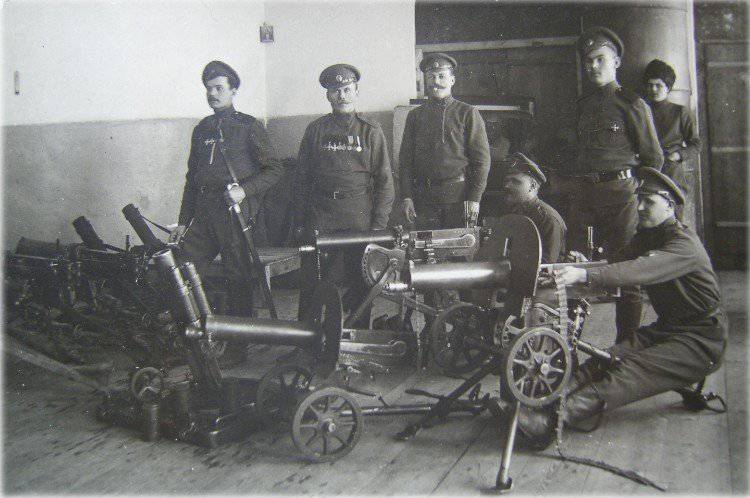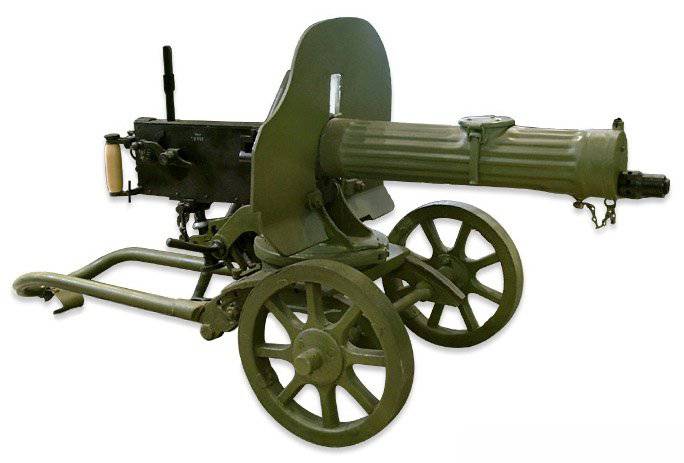Machine guns before the First World War

By the beginning of the war, the Russian army was armed with three models of machine guns, which were modifications of the system that the American designer H.S. created in the 1880s. Maxim - "Maxim" of the 1910 model (the main model), the 1905 model of the production of ITOZ (Imperial Tula weapons factory) and Vickers machine guns. "Maxims", acquired in Germany and the UK at the turn of the XIX-XX centuries, remained in the fortresses and warehouses.
The forerunners of automatic machine guns, both technically and tactically, were the “grip” gun-case. The most popular was the Gatling buckskin with the carousel installation of box magazines. The name “machine gun” in Russia was precisely the narticles of the Gatling-Baranovsky and Gatling-Gorlov systems.
On July 10, the National Defense Council of 1906 approved an introduction to each cavalry division and each infantry regiment of a machine-gun company, which more closely resembled light artillery batteries. The “Small Army Strengthening Program” adopted by 10 on July 1913 of the year envisaged the completion of the supply of machine guns for five years (according to the 1906 plan of the year), the conversion of the heavy machine guns of the 1905 model of the year to the “light” model of the 1910 of the year and the completion of the preparation of cartridges. The “big program”, which envisaged bringing the production up to a thousand machine guns a year, did not even begin to implement.

Manual machine guns, despite the fact that they were armed in some armies, did not receive a clear place in the armament system - in some armies they were considered armament of cavalry, in other means of self-defense of artillery, but nowhere they were expected to be of substantial value as an infantry weapon. In Russia, Madsen light machine guns (which were then also called “machine guns”) acquired during the Russo-Japanese War were tested in Cossack and cavalry units. In the 1912 year, after they adopted the Maxim machine gun on the Sokolov machine, the light machine guns were handed over to the fortresses. In addition, light machine guns were considered as a possible weaponry of light boats, airships, airplanes. In Russia, in 1911 -1913, the Mac Klen-Lewis and Hotchkis machine guns were tested at the Gunnery range of the Officers' Infantry School. The estimate for 1914 for the year provided for the purchase of two Berthier rifles, three Hotchkiss and ten Lewis for testing (for installation on airplanes; in the 1912, shooting from aircraft was conducted in the United States and in France). But in August 1913 of the year. The aeronautical part of the GUGSH (Main Department of the General Staff) decided to contain Vickers machine guns for arming airplanes and Maxim for aerostats.
According to the 1910 plan of the year and the instructions given at different times, arming the 32 machine guns with cavalry and 504 infantry regiments, together with the creation of the 10 percentage reserve, was to be completed by January 1915. By this time there should have been all 4990 machine guns: in the cavalry - 256, in the infantry - 4288, in stock - 454. By July, the 1914 in the army had 356 machinegun calculations (first line of infantry), 6 teams in the Zaamursky district (border guards), 32 cavalry teams. In the second stage, there were 120 machine-gun teams, the troops had 4098 machine guns, there were 69 machine guns in stock, with a total shortage - 833 units. (in the first line of the French forces, the shortage was 800 machine guns). In the 1914, in the Russian infantry division there were 32 machine guns, in the German and French - on 24, in the Russian cavalry division - 8 machine guns, in the French - 6. The norms of supplying machine guns at that time seemed sufficient. Many believed that "now you can be calm for a machine-gun business." In Russia, stocks of rifle cartridges amounted to just 2600 million, although 2829 million was required, even at significantly lower rates.
Based on: S. Fedoseev - Machine Guns in the First World War
Information